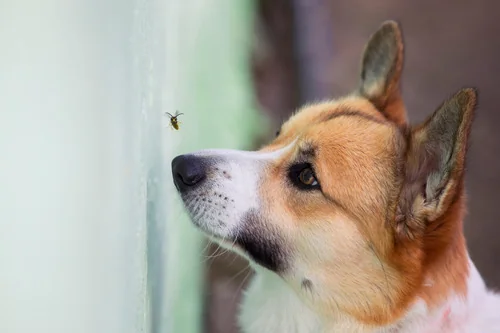A bee sting can be a startling experience for any dog and their owner. While bees play an essential role in our ecosystem, their stings can cause discomfort and, in some cases, serious reactions in dogs. Understanding how to recognize a dog bee sting, the potential reactions, and when to seek veterinary care is crucial for every dog owner. In this article, we’ll explore everything you need to know about dog bee stings to ensure your pet’s safety and well-being.

Recognizing a Dog Bee Sting
A dog bee sting is usually easy to spot if you know what to look for. Dogs are curious creatures, often sniffing around gardens, flowers, and grassy areas where bees are active. After a bee sting, your dog might exhibit immediate symptoms such as swelling, redness, and pain at the sting site. They might also yelp, lick, or chew the affected area. In some cases, the sting may cause hives, which appear as raised bumps on the skin. Here are more common signs that your dog has been stung by a bee:
Behavioral Changes
Watch for any changes in your dog’s behavior. They might become restless, agitated, or unusually quiet. Some dogs might limp if stung on the paw or refuse to put weight on the affected limb. Excessive scratching or rubbing the sting site is also a common reaction.
Allergic Reactions
While most bee stings cause mild reactions, some dogs can have severe allergic reactions. Symptoms to watch for include difficulty breathing, vomiting, diarrhea, or collapsing. These signs require immediate veterinary attention.
Immediate Steps to Take
If your dog is stung by a bee, there are several steps you can take to provide comfort and prevent complications.
- Remove the Stinger: The first step is to check the sting site and remove the stinger if it’s still embedded in the skin. Use a flat object like a credit card to scrape it out gently. Avoid using tweezers as squeezing the stinger can release more venom.
- Clean the Area: Gently clean the affected area with mild soap and water to prevent infection. Pat the area dry with a clean cloth.
- Apply a Cold Compress: To reduce swelling and pain, apply a cold compress to the sting site. Wrap some ice in a cloth and hold it against the area for a few minutes. This can help minimize inflammation and provide relief to your dog.
When to Call the Vet
Knowing when to seek veterinary care is essential in managing dog bee stings. While mild reactions can often be managed at home, certain situations require professional help.
Severe Reactions
If your dog shows signs of a severe allergic reaction, such as difficulty breathing, excessive swelling, vomiting, or collapse, contact Palos Animal Hospital immediately at (708) 448-6600. These symptoms indicate a potentially life-threatening situation that requires urgent care.
Multiple Stings
Multiple bee stings can cause a significant amount of venom to enter your dog’s system, increasing the risk of a severe reaction. If your dog is stung multiple times, it’s best to seek veterinary advice promptly.
Continued Discomfort
If your dog continues to show signs of pain, swelling, or discomfort after several hours, consult your veterinarian. Persistent symptoms might indicate an infection or an allergic reaction that needs medical attention.
Preventing Bee Stings
While it’s impossible to protect your dog from every bee, there are steps you can take to reduce the risk of bee stings.
- Avoid High-Risk Areas: Keep your dog away from areas with high bee activity, such as flowering gardens, meadows, and orchards. Bees are most active during warm weather, so be extra cautious during these times.
- Supervise Outdoor Activities: Supervising your dog’s outdoor activities can help you intervene quickly if they encounter bees. Keep an eye on where your dog is sniffing and playing, especially around flowers and plants.
- Training: Training your dog to avoid bees can be beneficial. Teach them commands like “leave it” to discourage them from investigating bees or other insects.
Long-Term Considerations
Understanding and managing dog bee stings involves more than just immediate care. Consider the following long-term aspects to ensure your dog’s safety.
Allergic Reactions
If your dog has a history of allergic reactions to bee stings, discuss preventative measures with your veterinarian. They might recommend carrying an EpiPen for emergencies or prescribing medications to have on hand.
Desensitization Therapy
In some cases, veterinarians might suggest desensitization therapy for dogs with severe allergies to bee stings. This involves exposing the dog to small amounts of bee venom over time to build tolerance.
Regular Check-ups
Regular veterinary check-ups can help monitor your dog’s health and identify any potential issues related to bee stings. Your vet can provide personalized advice and preventative measures based on your dog’s specific needs.
Protecting Your Dog from Bee Stings
Dog bee stings are a common yet manageable issue for pet owners. By recognizing the signs, taking immediate action, and knowing when to seek veterinary care, you can help your dog recover quickly and safely. For any concerns or severe reactions, contact Palos Animal Hospital at (708) 448-6600 for professional assistance. Your pet’s well-being is our focus, and we are here to provide the care and support you need.


